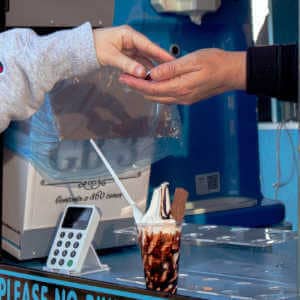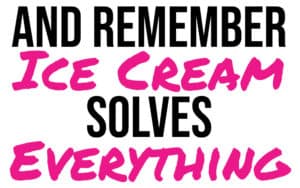What is the mark-up on ice cream? You serve amazing ice cream, but how much money does each scoop make you? Deciding on the mark-up for your ice cream is one of the most important decisions you will have to make. Get it wrong and it could be the end of your business. Set it too high and people may not buy your ice cream. Set it too low and you won’t make any money on your ice cream. That’s why in this post I want to go over everything you need to know for setting the mark-up in your ice cream. In it, I will explain what the average profit margin is on ice cream, how much profit an ice cream shop can make, and what the mark-up is like for different kinds of ice cream operations.
To start with, let’s get an idea of what the mark-up on ice cream is?
What is the Mark-Up on Cream?
As a general rule, the mark-up in ice cream varies, however, you can expect a mark-up of 200-300% for an artisan scooped ice cream. This means that if a scoop of ice cream costs $5, it will cost $1.25-$1.65 to buy the raw ingredients to make the scoop as well as the cup and spoon it is served in.

What Is the Average Profit Margin on Ice Cream?
As a general rule, the average gross profit margin on artisan ice cream is around 67%-75%.
At this point, you may be wondering what the difference is between mark-up and gross profit margin. Mark-up refers to how much you charge for your scooped ice cream vs how much it cost to make. To work out mark-up you start with what the cost of making the ice cream is and work upwards.
Gross Profit, however, works backward. For gross profit, you start with your end sale price and work out how much you make based on this minus your cost of goods sold.
Gross Profit
Put another way, the cost of ingredients to make a scoop of ice cream, plus the cost of the cup and spoon to serve it in, tends to cost around 25%-33% of the sale price. So, if a scoop of ice cream costs $5 for the consumer, it will cost $1.25-$1.65 for the ingredients, cup, and spoon. Therefore, the mark-up is 200%-300%. These figures are all before the cost of labor to make the ice cream, as well as rent, utilities, and other costs of running an ice cream shop.
How Much Gross Profit Should I Be Making?
In my post Ice Cream Shop Profits, I go into detail about the profit margins you want to be making. However, it is so important it is worth repeating here again.
On average, you want to make sure you make a minimum of a 70% Gross Profit Margin on your ice cream. This means your Costs of Goods Sold (COGS), i.e., how much it costs you to make the ice cream, is no higher than 30%.
This 70/30 rule is one of my golden rules.
Why is the 70/30 Rule Important?
The 70/30 rule is so important because without it will be hard to cover all the other expenses involved in your business and make a net profit.
Let me put this into context. You sell a scoop of ice cream for $5. Utilizing the 70/30 rule this scoop should cost no more than $1.50. Leaving you with $3.50 of gross profit. This $3.50 then must go towards covering all your operating and non-operating expenses. Things like rent, utilities, taxes, payroll, expenses, and most importantly some money for you.
That means if you just sell $1,000 worth of single ice cream scoops in a day you will have $700 left to cover everything else.
When you start to get below 70 below for gross margin the issue is that there usually isn’t enough to cover everything else and still pay you. That is why it is so important why you need to make sure as a minimum you are making 70% on everything you sell.
Overrun
The good news is that ice cream has a secret weapon which means reaching 70% gross margins is much easier than in other industries. Want to know what it is? I will tell you – it is called “Overrun” and involves “air”. Yep, air.
I go into detail on “overrun” in my post: What Are The Different Types of Frozen Desserts. For now, you just need to understand that the way ice cream is made involves whipping in air as the ice cream mix is frozen. The result is a larger volume output compared to the input mixture.
That’s right – when you make ice cream you get a greater volume of ice cream than you put in. This is because air is whipped into the ice cream and expands its volume. It is what helps create light, and smooth-tasting ice creams.
It also means you get more scoops of ice cream from a single batch of ice cream. For example, if you double the volume, you can get double the number of scoops. This then effectively reduces your cost of goods sold and increases your margins.
The bad news is that controlling exactly levels of overrun is very difficult to do – with rates depending on recipes and ice cream machines used.

How Much Profit Does An Ice Cream Shop Make?
As a general rule, a successful independent ice cream shop will tend to make a 10%-20% net profit. This figure is the final profit after all the ice cream shop’s expenses including wages rent, utilities, permits, insurance, and miscellaneous costs.
You can read more about the profits an ice cream shop can make here – Ice Cream Shops Profits – How To Run A Profitable Ice Cream Shop.
What is the Profit Margin on Soft Serve Ice Cream?
The profit margin on soft serve tends to be a lot higher for soft-serve than for scooped ice cream. This is for several reasons:
1. Ingredient costs:
As a general rule, soft-serve tends to be made from lower quality ingredients than scooped ice cream. A lot of soft serves are made from powder plus tap water. For example, this chocolate powdered soft serve mix on Amazon currently costs 14.3 cents for a kid’s serving worth. If you charged $2.50 for this that would be a 1,750% mark up. In comparison, have you ever heard of scooped ice cream being made from powder and tap water?
2. Overrun
More air is pumped into soft-serve ice cream than scooped ice cream. Overrun is much higher in soft serve than scoops.
3. Add-Ins
Soft serve ice cream can’t have add-ins (such as cookie pieces, etc), mixed into the soft serve mixture. This is because soft-serve machines are not able to handle mixtures with any chunks in them. Soft Serve machine mixtures need to be as smooth as possible.
As a general rule, ice creams with add-ins (cookie pieces, fudge, fruit pieces, nuts, chocolate pieces) are the most expensive forms of ice cream to make. In my ice cream shop, the flavors with add-ins are by far my most expensive ice cream flavors to make. But guess what – they are also the most popular – resulting in higher sales.
Soft-Serve Ice Cream Businesses
Be aware of going for soft-serve ice cream rather than scooped ice cream in your ice cream shop. You may well have higher sales selling a high-quality low overrun scooped ice cream with add-ins than a high overrun, powdered soft serve mix – even if the cost of goods sold is higher.
Also remember, the up-front machinery costs, as well as maintenance costs, are higher with soft serve machines rather than batch freezers. You are also more limited in numbers and types of flavors with soft-serve which could result in lower sales. I used to sell soft serve (we made the mix in-house from quality ingredients). When we moved from soft serve to scooped, our cost of goods sold went up – but so did our sales.
Our sales went up by a much larger percentage than our cost of goods sold.
If you would like to read more about the profits involved in soft-serve ice cream, as well as the challenges you can here – Everything You Need To Know About Soft Serve Ice Cream.
Rolled Ice Cream Profit Margin
As a whole, because very little/no air is whipped into rolled ice cream, the cost of ingredients in rolled ice cream is on the higher side. This means reduced profit margins. A higher price point can, however, be charged for rolled ice cream. You can read more about the rolled ice cream business generally here: Everything You Need To Know About Rolled Ice Cream.

What is the Mark-Up On Ice Cream – The Final Lick
What is the mark-up on ice cream? When you start an ice cream business it doesn’t matter how great your ice cream is. If you get your margins and gross profits wrong your business will not be around long. In fact, this is true for any type of business. It doesn’t matter if you are selling ice cream or selling shoes. Making sure you hit the right gross margins is entrepreneur 101.
Running an ice cream business, however, is so much more advantageous compared to other types of business because of the element of overrun. Utilizing overrun means ice cream makers can decrease the costs of goods sold and make more margin. Something no other industry really does in my experience.
In my ice cream store, I have had to constantly adjust and change prices. Setting pricing is hard. You want to charge the most you can for your ice cream before the price starts to result in decreased sales. If at this point you are not making at least 70% gross margin – you need to go away and seriously think about your business model.

Time To Learn Some More
Want to learn more on your path to ice cream entrepreneur success. Then check out some of my other articles.
- What Are the Challenges In An Ice Cream Business
- How Do I Start My Own Ice Cream Business
- Ice Cream Shop Profits – How To Run A Profitable Ice Cream Shop
- How Much Does It Cost To Start An Ice Cream Truck
- How Much Does It Cost To Start An Ice Cream Shop
- Ice Cream Shop Accounting – Everything You Need To Know
- Can I Make Ice Cream At Home And Sell It
- What Are the Different Types of Frozen Desserts?
- Is Vegan Ice Cream Profitable
- What Equipment Do I Need For My Ice Cream Truck
- How To Pick A Generator For Your Ice Cream Truck
- How Profitable Is An Ice Cream Truck?
- Everything You Need To Know About Working In An Ice Cream Shop
- Everything You Need to Know About Writing an Ice Cream Business Plan
- Everything You Need To Know About Rolled Ice Cream
- Everything You Need To Know About Soft Serve Ice Cream
- Vegan “Ice Cream”
- Everything You Need To Know About Batch Freezers
- What Equipment Do You Need For An Ice Cream Shop
- What Supplies Do You Need For An Ice Cream Shop
- What Is The Best Location For An Ice Cream Shop
- How To Open An Ice Cream Shop
- How To Start An Ice Cream Truck
- Do Ice Cream Shops Make Money in the Winter
- How To Make An Ice Cream Shop Stand Out
- How Do You Become An Ice Cream Distributor
- Everything You Need To Know About Ice Cream Delivery Apps
- Everything You Need To Know About Gluten-Free Ice Cream and Toppings
- What Scoopers Do Ice Cream Shops Use?
- What Are the Best Toppings and Sauces for Ice Cream?


